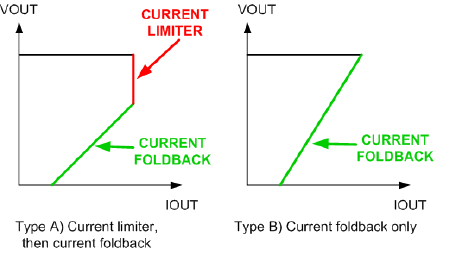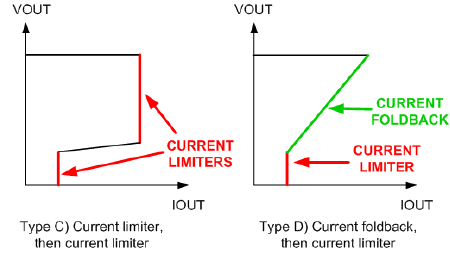This section explains the voltage regulator current limiter characteristic VOUT vs IOUT) method.
The same current limiter function is also used for switching power supplies (DC/DC and AC/DC), etc.
Current limiter classification
The current limiters built into voltage regulators can be classified into 4 main types.
A) Drooping type current limiter ⇒ Foldback current limiter
B) Foldback current limiter only
C) Drooping type current limiter ⇒ Drooping type current limiter
D) Foldback type current limiter ⇒ Drooping type current limiter
For example, for Type A, the drooping type current limiter initially activates and then is followed by the activation of the foldback current limiter, so this is expressed as “A) Drooping type current limiter ⇒ Foldback current limiter.”


Current limiter history and characteristics
A) Drooping type current limiter ⇒ Foldback current limiter
Conventional voltage regulators (XC6204, XC6219, etc.) employed Type A (Drooping type ⇒ Foldback). This foldback current limiter was not sufficiently accurate, however, so a drooping type current limiter was added.
B) Foldback current limiter only
Later, high-accuracy control became possible using just a foldback limiter.
This led to the commercialization of Type B (Foldback only) voltage regulators, which employed a foldback limiter that can detect overcurrent.
With foldback limiters, however, if there is even a slight negative output voltage before startup, there is a possibility the output voltage cannot be started.
This is because if the output voltage is negative, the amount of current that can be supplied by the voltage regulator is 0mA, which could cause the circuit to balance while current is not being supplied to the output side.
C) Drooping type current limiter ⇒ Drooping type current limiter
The foldback current startup problem can be avoided by using a voltage regulator that employs a drooping type current limiter during a short circuit. This is the background behind the introduction of the Type C (Drooping type ⇒ Drooping Type) voltage regulator (XC6223, XC6503, etc.).
Additionally, the drooping type current limiter provides excellent control of the current limit value.
With the Type C voltage regulator, the current limit value is constant when the output voltage is 1V or higher, so the heater generation is greater than with Types A and B, so there is a problem with junction temperature increase during current limitation.
Further, the junction temperature increase problem can be countered by building in a thermal shutdown function.
D) Foldback type current limiter ⇒ Drooping type current limiter
In regards to the junction temperature increase during current limiting, which is a problem with Type C (Drooping type ⇒ Drooping type), employing a Type D (Foldback ⇒ Drooping Type) current limiter generates less heat during current limiting than does Type C.
List of Types of Voltage Regulator Current Limiters
| TYPE A (Drooping type ⇒Foldback) | TYPE B (Foldback only) | TYPE C (Drooping type ⇒ Drooping type) | TYPE D (Foldback ⇒ Drooping type) |
|---|---|---|---|
| XC6231 XC6224 XC6220 XC6219 XC6213 XC6210 XC6209 XC6206 XC6205 XC6204 XC6504 XC6601 | XC6242 XC6241 XC6240 XC6227 XC6225 XC6222 XC6221 XC6218 XC6217 XC6216 XC6215 XC6214 XC6206 XC6506 XC6501 XC6604 XC6603 XC6602 XC6706 XC6705 XC6702 XC6701 XC6902 XC6901 | XC6230 XC6229 XC6228 XC6223 XC6505 | XC6233 XC6505 |